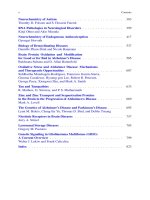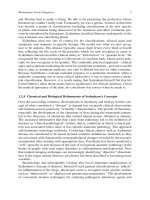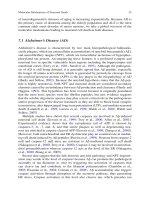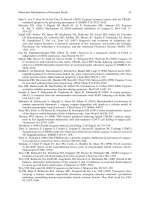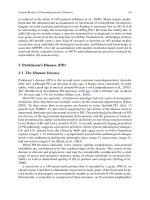Neurochemical Mechanisms in Disease P65 pps
Bạn đang xem bản rút gọn của tài liệu. Xem và tải ngay bản đầy đủ của tài liệu tại đây (105.34 KB, 10 trang )
Oxidative Stress and AD: Mechanisms and Therapeutics 625
Lemos RR, Castelletti C, Lima Filho JL, Marques ET, Oliveira JR (2009) In Silico Identification
of New Genetic Variations as Potential Risk Factors for Alzheimer’s Disease in a Microarray-
oriented Simulation. J Mol Neurosci 39(1–2):242–247
Liu R, Zhou XW, Tanila H, Bjorkdahl C, Wang JZ, Guan ZZ, Cao Y, Gustafsson JA, Winblad B,
Pei JJ (2008) Phosphorylated PP2A (tyrosine 307) is associated with Alzheimer neurofibrillary
pathology. J Cell Mol Med 12(1):241–257
Lleo A, Greenberg SM, Growdon JH (2005) Current Pharmacotherapy for Alzheimer’s Disease.
Annu Rev Med 57:513–533
Lopez-Bastida J, Hart W, Garcia-Perez L, Linertova R (2009) Cost-effectiveness of donepezil in
the treatment of mild or moderate Alzheimer’s disease. J Alzheimers Dis 16:399–407
Louvi A, Sisodia SS, Grove EA (2004) Presenilin 1 in migration and morphogenesis in the central
nervous system. Development 131:3093–3105
Lovell MA, Robertson JD, Teesdale WJ, Campbell JL, Markesbery WR (1998) Copper, iron and
zinc in Alzheimer’s disease senile plaques. J Neurol Sci 158:47–52
Lu Z, Nie G, Li Y, Soe-Lin S, Tao Y, Cao Y, Zhang Z, Liu N, Ponka P, Zhao B (2009)
Overexpression of Mitochondrial Ferritin Sensitizes Cells to Oxidative Stress Via an Iron-
Mediated Mechanism. Antioxid Redox Signal 11(8):1791–1803
Luchsinger JA, Tang MX, Shea S, Mayeux R (2003) Antioxidant vitamin intake and risk of
Alzheimer disease. Arch Neurol 60:203–208
Matsuda JI, Kaminaka K, Nozaki C (2009) Amyloid beta peptides with an additional cysteine
residue can enhance immunogenicity and reduce the amyloid beta burden in an Alzheimer’s
disease mouse model. Biochem Biophys Res Commun 382(1):149–152
Mattson MP, Chan SL, Duan W (2002) Modification of brain aging and neurodegenerative
disorders by genes, diet, and behavior. Physiol Rev 82:637–672
McGonigal G, Thomas B, McQuade C, Starr JM, MacLennan WJ, Whalley LJ (1993)
Epidemiology of Alzheimer’s presenile dementia in Scotland, 1974–88. BMJ (Clinical
research ed) 306:680–683
McShea A, Ramiro-Puig E, Munro SB, Casadesus G, Castell M, Smith MA (2008) Clinical benefit
and preservation of flavonols in dark chocolate manufacturing. Nutr Rev 66:630–641
Migliore L, Coppede F (2009) Environmental-induced oxidative stress in neurodegenerative
disorders and aging. Mutat Res 674:73–84
Mondragon-Rodriguez S, Basurto-Islas G, Santa-Maria I, Mena R, Binder LI, Avila J, Smith MA,
Perry G, Garcia-Sierra F (2008a) Cleavage and conformational changes of tau protein follow
phosphorylation during Alzheimer’s disease. Int J Exp Path 89(2):81–90
Mondragon-Rodriguez S, Mena R, Binder LI, Smith MA, Perry G, Garcia-Sierra F (2008b)
Conformational changes and cleavage of tau in Pick bodies parallel the early processing of
tau found in Alzheimer pathology. Neuropathol Appl Neurobiol 34:62–75
Monsonego A, Zota V, Karni A, Krieger JI, Bar-Or A, Bitan G, Budson AE, Sperling R, Selkoe
DJ, Weiner HL (2003) Increased T cell reactivity to amyloid beta protein in older humans and
patients with Alzheimer disease. J Clin Invest 112:415–422
Montgomery SA, Thal LJ, Amrein R (2003) Meta-analysis of double blind randomized controlled
clinical trials of acetyl-L-carnitine versus placebo in the treatment of mild cognitive impairment
and mild Alzheimer’s disease. Int Clin Psychopharmacol 18:61–71
Moreira PI, Nunomura A, Nakamura M, Takeda A, Shenk JC, Aliev G, Smith MA, Perry
G (2008) Nucleic acid oxidation in Alzheimer disease. Free Radic Biol Med 44(8):
1493–1505
Moreira PI, Siedlak SL, Wang X, Santos MS, Oliveira CR, Tabaton M, Nunomura A, Szweda LI,
Aliev G, Smith MA, Zhu X, Perry G (2007) Autophagocytosis of mitochondria is prominent in
Alzheimer disease. J Neuropathol Exp Neurol 66:525–532
Moreira PI, Zhu X, Nunomura A, Smith MA, Perry G (2006) Therapeutic options in Alzheimer’s
disease. Expert Rev Neurother 6:897–910
Moriguchi S, Zhao X, Marszalec W, Yeh JZ, Fukunaga K, Narahashi T (2009) Nefiracetam and
galantamine modulation of excitatory and inhibitory synaptic transmission via stimulation
626 S. Mondragón-Rodríguez et al.
of neuronal nicotinic acetylcholine receptors in rat cortical neurons. Neuroscience 160(2):
484–491
Morris MC, Evans DA, Bienias JL, Tangney CC, Bennett DA, Aggarwal N, Wilson RS, Scherr PA
(2002a) Dietary intake of antioxidant nutrients and the risk of incident Alzheimer disease in a
biracial community study. J Am Med Assoc 287:3230–3237
Morris MC, Evans DA, Bienias JL, Tangney CC, Wilson RS (2002b) Vitamin E and cognitive
decline in older persons. Arch Neurol 59:1125–1132
Mosconi L, Nacmias B, Sorbi S, De Cristofaro MT, Fayazz M, Tedde A, Bracco L, Herholz K, Pupi
A (2004) Brain metabolic decreases related to the dose of the ApoE e4 allele in Alzheimer’s
disease. J Neurol Neurosurg Psychiatry 75:370–376
Mosconi L, Pupi A, De Leon MJ (2008) Brain glucose hypometabolism and oxidative stress in
preclinical Alzheimer’s disease. Ann N Y Acad Sci 1147:180–195
Nakamura M, Shishido N, Nunomura A, Smith MA, Perry G, Hayashi Y, Nakayama K, Hayashi
T (2007) Three histidine residues of amyloid-beta peptide control the redox activity of copper
and iron. Biochemistry (Mosc) 46:12737–12743
Nunomura A, Castellani RJ, Zhu X, Moreira PI, Perry G, Smith MA (2006) Involvement of
oxidative stress in Alzheimer disease. J Neuropathol Exp Neurol 65:631–641
Nunomura A, Chiba S, Lippa CF, Cras P, Kalaria RN, Takeda A, Honda K, Smith MA, Perry G
(2004) Neuronal RNA oxidation is a prominent feature of familial Alzheimer’s disease.
Neurobiol Dis 17:108–113
Nunomura A, Moreira PI, Lee HG, Zhu X, Castellani RJ, Smith MA, Perry G (2007a) Neuronal
death and survival under oxidative stress in Alzheimer and Parkinson diseases. CNS Neurol
Disord Drug Targets 6:411–423
Nunomura A, Moreira PI, Takeda A, Smith MA, Perry G (2007b) Oxidative RNA damage and
neurodegeneration. Curr Med Chem 14:2968–2975
Nunomura A, Perry G, Aliev G, Hirai K, Takeda A, Balraj EK, Jones PK, Ghanbari H, Wataya T,
Shimohama S, Chiba S, Atwood CS, Petersen RB, Smith MA (2001) Oxidative damage is the
earliest event in Alzheimer disease. J Neuropathol Exp Neurol 60:759–767
Nunomura A, Perry G, Pappolla MA, Friedland RP, Hirai K, Chiba S, Smith MA (2000) Neuronal
oxidative stress precedes amyloid-beta deposition in Down syndrome. J Neuropathol Exp
Neurol 59:1011–1017
Nunomura A, Perry G, Pappolla MA, Wade R, Hirai K, Chiba S, Smith MA (1999) RNA oxi-
dation is a prominent feature of vulnerable neurons in Alzheimer’s disease. J Neurosci 19:
1959–1964
Paola D, Domenicotti C, Nitti M, Vitali A, Borghi R, Cottalasso D, Zaccheo D, Odetti P, Strocchi
P, Marinari UM, Tabaton M, Pronzato MA (2000) Oxidative stress induces increase in intracel-
lular amyloid beta-protein production and selective activation of betaI and betaII PKCs in NT2
cells. Biochem Biophys Res Commun 268:642–646
Perkins AJ, Hendrie HC, Callahan CM, Gao S, Unverzagt FW, Xu Y, Hall KS, Hui SL (1999)
Association of antioxidants with memory in a multiethnic elderly sample using the Third
National Health and Nutrition Examination Survey. Am J Epidemiol 150:37–44
Perry G, Nunomura A, Raina AK, Aliev G, Siedlak SL, Harris PL, Casadesus G, Petersen RB,
Bligh-Glover W, Balraj E, Petot GJ, Smith MA (2003) A metabolic basis for Alzheimer disease.
Neurochem Res 28:1549–1552
Perry G, Nunomura A, Raina AK, Smith MA (2000) Amyloid-beta junkies. Lancet 355:757
Perry G, Smith MA, McCann CE, Siedlak SL, Jones PK, Friedland RP (1998) Cerebrovascular
muscle atrophy is a feature of Alzheimer’s disease. Brain Res 791:63–66
Perry G, Taddeo MA, Nunomura A, Zhu X, Zenteno-Savin T, Drew KL, Shimohama S, Avila
J, Castellani RJ, Smith MA (2002) Comparative biology and pathology of oxidative stress
in Alzheimer and other neurodegenerative diseases: beyond damage and response. Comp
Biochem Physiol C Toxicol Pharmacol 133:507–513
Pope S, Land JM, Heales SJ (2008) Oxidative stress and mitochondrial dysfunction in neurode-
generation; cardiolipin a critical target? Biochim Biophys Acta 1777:794–799
Oxidative Stress and AD: Mechanisms and Therapeutics 627
Praprotnik D, Smith MA, Richey PL, Vinters HV, Perry G (1996) Filament heterogeneity within the
dystrophic neurites of senile plaques suggests blockage of fast axonal transport in Alzheimer’s
disease. Acta Neuropathol (Berl) 91:226–235
Pratico D, Trojanowski JQ (2000) Inflammatory hypotheses: novel mechanisms of Alzheimer’s
neurodegeneration and new therapeutic targets? Neurobiol Aging 21:441–445; discussion
451–443
Pratico D, Uryu K, Sung S, Ta ng S, Trojanowski JQ, Lee VM (2002) Aluminum modulates brain
amyloidosis through oxidative stress in APP transgenic mice. FASEB J 16:1138–1140
Ramiro-Puig E, Casadesus G, Lee HG, Zhu X, McShea A, Perry G, Perez-Cano FJ, Smith MA,
Castell M (2009) Neuroprotective effect of cocoa flavonoids on in vitro oxidative stress. Eur J
Nutr 48:54–61
Rankin CA, Sun Q, Gamblin TC (2005) Pseudo-phosphorylation of tau at Ser202 and Thr205
affects tau filament formation. Brain Res Mol Brain Res 138:84–93
Rapoport SI (2003) Coupled reductions in brain oxidative phosphorylation and synaptic function
can be quantified and staged in the course of Alzheimer disease. Neurotox Res 5:385–398
Rapp SR, Espeland MA, Shumaker SA, Henderson VW, Brunner RL, Manson JE, Gass ML,
Stefanick ML, Lane DS, Hays J, Johnson KC, Coker LH, Dailey M, Bowen D (2003)
Effect of estrogen plus progestin on global cognitive function in postmenopausal women: the
Women’s Health Initiative Memory Study: a randomized controlled trial. J Am Med Assoc
289:2663–2672
Resnick SM, Henderson VW (2002) Hormone therapy and risk of Alzheimer disease: a critical
time. J Am Med Assoc 288:2170–2172
Reynolds CH, Nebreda AR, Gibb GM, Utton MA, Anderton BH (1997) Reactivating kinase/p38
phosphorylates tau protein in vitro. J Neurochem 69:191–198
Rocca WA, Hofman A, Brayne C, Breteler MM, Clarke M, Copeland JR, Dartigues JF, Engedal
K, Hagnell O, Heeren TJ, Jonker C, Lindesay J, Lobo A, Mann AH, Molsa PK, Morgan K,
O’Connor DW, da Silva Droux A, Sulkava R, Kay DWK, Amaducci L; EURODEM-Prevalence
Research Group (1991) Frequency and distribution of Alzheimer’s disease in Europe: a collab-
orative study of 1980–1990 prevalence findings. The EURODEM-Prevalence Research Group.
Ann Neurol 30:381–390
Rogers JT, Randall JD, Cahill CM, Eder PS, Huang X, Gunshin H, Leiter L, McPhee J, Sarang SS,
Utsuki T, Greig NH, Lahiri DK, Tanzi RE, Bush AI, Giordano T, Gullans SR (2002) An iron-
responsive element type II in the 5
-untranslated region of the Alzheimer’s amyloid precursor
protein transcript. J Biol Chem 277:45518–45528
Rottkamp CA, Raina AK, Zhu X, Gaier E, Bush AI, Atwood CS, Chevion M, Perry G, Smith MA
(2001) Redox-active iron mediates amyloid-beta toxicity. Free Radic Biol Med 30:447–450
Sajad M, Zargan J, Chawla R, Umar S, Sadaqat M, Khan HA (2009) Hippocampal neurodegen-
eration in experimental autoimmune encephalomyelitis (EAE): potential role of inflammation
activated myeloperoxidase. Mol Cell Biochem 328(1–2):183–188
Sano M, Ernesto C, Thomas RG, Klauber MR, Schafer K, Grundman M, Woodbury P, Growdon
J, Cotman CW, Pfeiffer E, Schneider LS, Thal LJ (1997) A controlled trial of selegiline, alpha-
tocopherol, or both as treatment for Alzheimer’s disease. The Alzheimer’s Disease Cooperative
Study. N Engl J Med 336:1216–1222
Santacruz K, Lewis J, Spires T, Paulson J, Kotilinek L, Ingelsson M, Guimaraes A, DeTure M,
Ramsden M, McGowan E, Forster C, Yue M, Orne J, Janus C, Mariash A, Kuskowski M,
Hyman B, Hutton M, Ashe KH (2005) Tau suppression in a neurodegenerative mouse model
improves memory function. Science 309:476–481
Sayre LM, Perry G, Harris PL, Liu Y, Schubert KA, Smith MA (2000) In situ oxidative catalysis
by neurofibrillary tangles and senile plaques in Alzheimer’s disease: a central role for bound
transition metals. J Neurochem 74:270–279
Schenk D, Barbour R, Dunn W, Gordon G, Grajeda H, Guido T, Hu K, Huang J, Johnson-Wood
K, Khan K, Kholodenko D, Lee M, Liao Z, Lieberburg I, Motter R, Mutter L, Soriano F,
Shopp G, Vasquez N, Vandevert C, Walker S, Wogulis M, Yednock T, Games D, Seubert P
628 S. Mondragón-Rodríguez et al.
(1999) Immunization with amyloid-beta attenuates Alzheimer-disease-like pathology in the
PDAPP mouse. Nature 400:173–177
Schindowski K, Belarbi K, Bretteville A, Ando K, Buee L (2008) Neurogenesis and cell
cycle-reactivated neuronal death during pathogenic tau aggregation. Genes Brain Behav 7
(Suppl 1):92–100
Shah RS, Lee HG, Xiongwei Z, Perry G, Smith MA, Castellani RJ (2008) Current approaches in
the treatment of Alzheimer’s disease. Biomed Pharmacother 62:199–207
Shepherd J, Blauw GJ, Murphy MB, Bollen EL, Buckley BM, Cobbe SM, Ford I, Gaw A, Hyland
M, Jukema JW, Kamper AM, Macfarlane PW, Meinders AE, Norrie J, Packard CJ, Perry IJ,
Stott DJ, Sweeney BJ, Twomey C, Westendorp RG (2002) Pravastatin in elderly individuals at
risk of vascular disease (PROSPER): a randomised controlled trial. Lancet 360:1623–1630
Short RA, Bowen RL, O’Brien PC, Graff-Radford NR (2001) Elevated gonadotropin levels in
patients with Alzheimer disease. Mayo Clin Proc 76:906–909
Smith MA (1998) Alzheimer disease. Int Rev Neurobiol 42:1–54
Smith MA, Atwood CS, Joseph JA, Perry G (2002a) Predicting the failure of amyloid-beta vaccine.
Lancet 359:1864–1865
Smith MA, Casadesus G, Joseph JA, Perry G (2002b) Amyloid-beta and tau serve antioxidant
functions in the aging and Alzheimer brain. Free Radic Biol Med 33:1194–1199
Smith MA, Harris PL, Sayre LM, Perry G (1997a) Iron accumulation in Alzheimer disease is a
source of redox-generated free radicals. Proc Natl Acad Sci U S A 94:9866–9868
Smith MA, Hirai K, Hsiao K, Pappolla MA, Harris PL, Siedlak SL, Tabaton M, Perry G (1998)
Amyloid-beta deposition in Alzheimer transgenic mice is associated with oxidative stress. J
Neurochem 70:2212–2215
Smith MA, Nunomura A, Zhu X, Takeda A, Perry G (2000a) Metabolic, metallic, and mitotic
sources of oxidative stress in Alzheimer disease. Antioxid Redox Signal 2:413–420
Smith MA, Petot GJ, Perry G (1999) Diet and oxidative stress: a novel synthesis of epidemiological
data on Alzheimer’s disease. J Alzheimers Dis 1:203–206
Smith MA, Richey Harris PL, Sayre LM, Beckman JS, Perry G (1997b) Widespread peroxynitrite-
mediated damage in Alzheimer’s disease. J Neurosci 17:2653–2657
Smith MA, Rottkamp CA, Nunomura A, Raina AK, Perry G (2000b) Oxidative stress in
Alzheimer’s disease. Biochim Biophys Acta 1502:139–144
Smith MA, Rudnicka-Nawrot M, Richey PL, Praprotnik D, Mulvihill P, Miller CA, Sayre LM,
Perry G (1995) Carbonyl-related posttranslational modification of neurofilament protein in the
neurofibrillary pathology of Alzheimer’s disease. J Neurochem 64:2660–2666
Smith MA, Taneda S, Richey PL, Miyata S, Yan SD, Stern D, Sayre LM, Monnier VM, Perry
G (1994) Advanced Maillard reaction end products are associated with Alzheimer disease
pathology. Proc Natl Acad Sci U S A 91:5710–5714
Sontag E, Nunbhakdi-Craig V, Lee G, Brandt R, Kamibayashi C, Kuret J, White CL 3rd,
Mumby MC, Bloom GS (1999) Molecular interactions among protein phosphatase 2A, tau,
and microtubules. Implications for the regulation of tau phosphorylation and the development
of tauopathies. J Biol Chem 274:25490–25498
Sorbi S, Bird ED, Blass JP (1983) Decreased pyruvate dehydrogenase complex activity in
Huntington and Alzheimer brain. Ann Neurol 13:72–78
Speranca MA, Batista LM, Lourenco Rda S, Tavares WM, Bertolucci PH, Rigolin Vde O,
Payao SL„ Smith Mde A (2008) Can the rDNA methylation pattern be used as a marker for
Alzheimer’s disease? Alzheimers Dement 4:438–442
Spires-Jones TL, Mielke ML, Rozkalne A, Meyer-Luehmann M, de Calignon A, Bacskai BJ,
Schenk D, Hyman BT (2009) Passive immunotherapy rapidly increases structural plasticity
in a mouse model of Alzheimer disease. Neurobiol Dis 33:213–220
Stackman RW, Eckenstein F, Frei B, Kulhanek D, Nowlin J, Quinn JF (2003) Prevention of age-
related spatial memory deficits in a transgenic mouse model of Alzheimer’s disease by chronic
Ginkgo biloba treatment. Exp Neurol 184:510–520
Oxidative Stress and AD: Mechanisms and Therapeutics 629
Swatton JE, Sellers LA, Faull RL, Holland A, Iritani S, Bahn S (2004) Increased MAP kinase activ-
ity in Alzheimer’s and Down syndrome but not in schizophrenia human brain. Eur J Neurosci
19:2711–2719
Szekely CA, Thorne JE, Zandi PP, Ek M, Messias E, Breitner JC, Goodman SN (2004)
Nonsteroidal anti-inflammatory drugs for the prevention of Alzheimer’s disease: a systematic
review. Neuroepidemiology 23:159–169
Takeda A, Loveman E, Clegg A, Kirby J, Picot J, Payne E, Green C (2006) A systematic review
of the clinical effectiveness of donepezil, rivastigmine and galantamine on cognition, quality of
life and adverse events in Alzheimer’s disease. Int J Geriatr Psychiatry 21:17–28
Tamagno E, Guglielmotto M, Aragno M, Borghi R, Autelli R, Giliberto L, Muraca G, Danni O, Zhu
X, Smith MA, Perry G, Jo DG, Mattson MP, Tabaton M (2008) Oxidative stress activates a pos-
itive feedback between the gamma- and beta-secretase cleavages of the beta-amyloid precursor
protein. J Neurochem 104:683–695
Thal LJ, Grundman M, Berg J, Ernstrom K, Margolin R, Pfeiffer E, Weiner MF, Zamrini E,
Thomas RG (2003) Idebenone treatment fails to slow cognitive decline in Alzheimer’s disease.
Neurology 61:1498–1502
Tian Q, Wang J (2002) Role of serine/threonine protein phosphatase in Alzheimer’s disease.
Neurosignals 11:262–269
Van Hoesen GW, Hyman BT (1990) Hippocampal formation: anatomy and the patterns of
pathology in Alzheimer’s disease. Prog Brain Res 83:445–457
Van Hoesen GW, Hyman BT, Damasio AR (1991) Entorhinal cortex pathology in Alzheimer’s
disease. Hippocampus 1:1–8
Veinbergs I, Mallory M, Sagara Y, Masliah E (2000) Vitamin E supplementation prevents spa-
tial learning deficits and dendritic alterations in aged apolipoprotein E-deficient mice. Eur J
Neurosci 12:4541–4546
Verdile G, Yeap BB, Clarnette RM, Dhaliwal S, Burkhardt MS, Chubb SA, De Ruyck K, Rodrigues
M, Mehta PD, Foster JK, Bruce DG, Martins RN (2008) Luteinizing hormone levels are pos-
itively correlated with plasma amyloid-beta protein levels in elderly men. J Alzheimers Dis
14:201–208
Vincent I, Jicha G, Rosado M, Dickson DW (1997) Aberrant expression of mitotic
cdc2/cyclin B1 kinase in degenerating neurons of Alzheimer’s disease brain. J Neurosci 17:
3588–3598
Vitali A, Piccini A, Borghi R, Fornaro P, Siedlak SL, Smith MA, Gambetti P, Ghetti B, Tabaton
M (2004) Soluble amyloid beta-protein is increased in frontotemporal dementia with tau gene
mutations. J Alzheimers Dis 6:45–51
Wallace DC (1999) Mitochondrial diseases in man and mouse. Science 283:1482–1488
Walsh DM, Selkoe DJ (2004) Oligomers on the brain: the emerging role of soluble protein
aggregates in neurodegeneration. Protein Pept Lett 11:213–228
Wang JZ, Grundke-Iqbal I, Iqbal K (2007a) Kinases and phosphatases and tau sites involved in
Alzheimer neurofibrillary degeneration. Eur J Neurosci 25:59–68
Wang YP, Song JF, Rao ZR (2004c) [CDK5 and neurodegenerative disease]. Sheng Li Ke Xue Jin
Zhan 35:45–48
Wang X, Su B, Fujioka H, Zhu X (2008a) Dynamin-like protein 1 reduction underlies mito-
chondrial morphology and distribution abnormalities in fibroblasts from sporadic Alzheimer’s
disease patients. Am J Pathol 173(2):470–482
Wang X, Su B, Perry G, Smith MA, Zhu X (2007b) Insights into amyloid-beta-induced mitochon-
drial dysfunction in Alzheimer disease. Free Radic Biol Med 43:1569–1573
Wang X, Su B, Siedlak SL, Moreira PI, Fujioka H, Wang Y, Casadesus G, Zhu X (2008b) Amyloid-
beta overproduction causes abnormal mitochondrial dynamics via differential modulation of
mitochondrial fission/fusion proteins. Proc Natl Acad Sci U S A 105:19318–19323
Wang PN, Yang CL, Lin KN, Chen WT, Chwang LC, Liu HC (2004b) Weight loss, nutritional
status and physical activity in patients with Alzheimer’s disease. A controlled study. J Neurol
251:314–320
630 S. Mondragón-Rodríguez et al.
Wang B, Zhang C, Zheng W, Lu Z, Zheng C, Yang Z, Wang L, Jin F (2004a) Association between
a T/C polymorphism in intron 2 of cholesterol 24S-hydroxylase gene and Alzheimer’s disease
in Chinese. Neurosci Lett 369:104–107
Webber KM, Casadesus G, Zhu X, Obrenovich ME, Atwood CS, Perry G, Bowen RL, Smith MA
(2006) The cell cycle and hormonal fluxes in Alzheimer disease: a novel therapeutic target.
Curr Pharm Des 12:691–697
Webber KM, Perry G, Smith MA, Casadesus G (2007) The contribution of luteinizing hormone to
Alzheimer disease pathogenesis. Clin Med Res 5:177–183
Webber KM, Raina AK, Marlatt MW, Zhu X, Prat MI, Morelli L, Casadesus G, Perry G, Smith
MA (2005) The cell cycle in Alzheimer disease: a unique target for neuropharmacology. Mech
Ageing Dev 126:1019–1025
Wilcock DM, Colton CA (2008) Anti-amyloid-beta immunotherapy in Alzheimer’s disease:
relevance of transgenic mouse studies to clinical trials. J Alzheimers Dis 15:555–569
Williamson J, LaRusse S (2004) Genetics and genetic counseling: recommendations for
Alzheimer’s disease, frontotemporal dementia, and Creutzfeldt-Jakob disease. Curr Neurol
Neurosci Rep 4:351–357
Wood JG, Mirra SS, Pollock NJ, Binder LI (1986) Neurofibrillary tangles of Alzheimer disease
share antigenic determinants with the axonal microtubule-associated protein tau (tau). Proc
Natl Acad Sci U S A 83:4040–4043
Xu J, Chen S, Ahmed SH, Chen H, Ku G, Goldberg MP, Hsu CY (2001) Amyloid-beta peptides
are cytotoxic to oligodendrocytes. J Neurosci 21:RC118
Yang W, Leystra-Lantz C, Strong MJ (2008) Upregulation of GSK3beta expression in frontal and
temporal cortex in ALS with cognitive impairment (ALSci). Brain Res 1196:131–139
Yankner BA, Duffy LK, Kirschner DA (1990) Neurotrophic and neurotoxic effects of amyloid beta
protein: reversal by tachykinin neuropeptides. Science 250:279–282
Yao M, Nguyen TV, Pike CJ (2005) Beta-amyloid-induced neuronal apoptosis involves c-Jun N-
terminal kinase-dependent downregulation of Bcl-w. J Neurosci 25:1149–1158
Younkin SG (1994) The amyloid beta protein precursor mutations linked to familial Alzheimer’s
disease alter processing in a way that fosters amyloid deposition. Tohoku J Exp Med 174:
217–223
Zawia NH, Lahiri DK, Cardozo-Pelaez F (2009) Epigenetics, oxidative stress, and Alzheimer
disease. Free Radic Biol Med 46(9):1241–1249
Zekanowski C, Golan MP, Krzysko KA, Lipczynska-Lojkowska W, Filipek S, Kowalska A, Rossa
G, Peplonska B, Styczynska M, Maruszak A, Religa D, Wender M, Kulczycki J, Barcikowska
M, Kuznicki J (2006) Two novel presenilin 1 gene mutations connected with frontotempo-
ral dementia-like clinical phenotype: genetic and bioinformatic assessment. Exp Neurol 200:
82–88
Zhou XW, Gustafsson JA, Tanila H, Bjorkdahl C, Liu R, Winblad B, Pei JJ (2008a) Tau hyper-
phosphorylation correlates with reduced methylation of protein phosphatase 2A. Neurobiol
Dis 31(3):386–394
Zhou XW, Tanila H, Pei JJ (2008b) Parallel increase in p70 kinase activation and tau phosphoryla-
tion (S262) with Abeta overproduction. FEBS Lett 582:159–164
Zhu X, Perry G, Moreira PI, Aliev G, Cash AD, Hirai K, Smith MA (2006) Mitochondrial
abnormalities and oxidative imbalance in Alzheimer disease. J Alzheimers Dis 9:
147–153
Zhu X, Raina AK, Lee HG, Casadesus G, Smith MA, Perry G (2004a) Oxidative stress signalling
in Alzheimer’s disease. Brain Res 1000:32–39
Zhu X, Raina AK, Rottkamp CA, Aliev G, Perry G, Boux H, Smith MA (2001a) Activation and
redistribution of c-jun N-terminal kinase/stress activated protein kinase in degenerating neurons
in Alzheimer’s disease. J Neurochem 76:435–441
Zhu X, Rottkamp CA, Boux H, Takeda A, Perry G, Smith MA (2000) Activation of p38 kinase
links tau phosphorylation, oxidative stress, and cell cycle-related events in Alzheimer disease.
J Neuropathol Exp Neurol 59:880–888
Oxidative Stress and AD: Mechanisms and Therapeutics 631
Zhu X, Rottkamp CA, Hartzler A, Sun Z, Takeda A, Boux H, Shimohama S, Perry G, Smith
MA (2001b) Activation of MKK6, an upstream activator of p38, in Alzheimer’s disease. J
Neurochem 79:311–318
Zhu X, Smith MA, Perry G, Aliev G (2004b) Mitochondrial failures in Alzheimer’s disease. Am J
Alzheimers Dis Other Demen 19:345–352
Zhu X, Su B, Wang X, Smith MA, Perry G (2007) Causes of oxidative stress in Alzheimer disease.
Cell Mol Life Sci 64:2202–2210
Zhu Y, Xiao K, Ma L, Xiong B, Fu Y, Yu H, Wang W, Wang X, Hu D, Peng H, Li J, Gong Q, Chai
Q, Tang X, Zhang H, Shen J (2009) Design, synthesis and biological evaluation of novel dual
inhibitors of acetylcholinesterase and beta-secretase. Bioorg Med Chem 17:1600–1613
Zou K, Gong JS, Yanagisawa K, Michikawa M (2002) A novel function of monomeric amyloid
beta-protein serving as an antioxidant molecule against metal-induced oxidative damage. J
Neurosci 22:4833–4841
Tau and Tauopathies
R. Mathew, G. Srinivas, and P.S. Mathuranath
Abstract Tau protein is a neuronal microtubule associated protein, which localizes
primarily in the axon. It plays a major role in promoting microtubule assembly,
stabilizing microtubules and maintaining the normal morphology of the neurons.
Structurally tau is a heterogenous molecule due to several posttranslational modifi-
cations. Tauopathies are a group of disorders that are the consequence of abnormal
tau phosphorylation, abnormal levels of tau, abnormal tau splicing, or mutations
in the tau gene. These disorders are characterized not only by neuronal, but
also oligodendroglial and astrocytic filamentous tau inclusions. Tauopathies are
the commonest among the neurodegerative diseases with filamentous inclusions.
Tauopathies include frontotemporal dementia, Parkinsonism plus syndromes, neuro-
muscular disorders, and certain genetic and metabolic syndromes. The occurrence of
neurofibrillary tangles in a wide range of conditions, including Alzheimer’s disease,
initially led to the suggestion that tau deposition may be an incidental nonspecific
finding associated with cell death or cellular dysfunction. Later the discovery of
close to 20 different mutations in tau in frontotemporal dementia with Parkinsonism
linked to chromosome-17 (FTDP-17) clearly showed that dysfunction of tau protein
causes neurodegeneration and dementia. Among the tauopathies, the most studied is
Alzheimer’s disease. Frontotemporal dementia, progressive supranuclear palsy, and
corticobasal ganglionic degeneration are some of the other common tauopathies
that have been extensively studied. Overlap of clinical and histopathological fea-
tures occurs between various tauopathies. The role of CSF tau in the diagnosis of
dementias is under investigation. The measures of total tau as well as species of
phospho-tau detected by antibodies in CSF correlates best with a diagnosis of AD.
The discovery of a tau transgenic mouse model has paved the way for testing various
therapeutic models for targeting tau.
P.S. Mathuranath (B)
Cognition and Behavioural Neurology Section (CBNC), Department of Neurology, Sree Chitra
Tirunal Institute for Medical Sciences and Technology (SCTIMST), Thiruvananthapuram 695011,
Kerala, India
e-mail:
633
J.P. Blass (ed.), Neurochemical Mechanisms in Disease,
Advances in Neurobiology 1, DOI 10.1007/978-1-4419-7104-3_19,
C
Springer Science+Business Media, LLC 2011
634 Mathew et al.
Keywords Tau · Tauopathy · Alzheimer’s disease · Frontotemporal dementia ·
Parkinsonism · Exon · Microtubule · Structural · Protein · Phosphorylation
Contents
1 Introduction 634
2 Biochemistry and Molecular Biology of Tau
635
2.1 Tau Gene
635
2.2 Structure, Cellular Localization, and Putative Functions of Tau Protein
636
2.3 Posttranslational Modifications of Tau
640
2.4 Turnover of Tau Protein
645
3 Tauopathies
646
3.1 Frontotemporal Dementia
647
3.2 Alzheimer’s Disease
649
3.3 Progressive Supranuclear Palsy
656
3.4 Corticobasalganglionic Degeneration
657
3.5 Multiple System Atrophy (MSA)
658
4 Future Direction
659
4.1 Tau as a Diagnostic Marker
659
4.2 Tau as a Therapeutic Target
660
4.3 Research Avenues
660
References
661
1 Introduction
Tau protein is a neuronal microtubule associated protein (MAP) that localizes pri-
marily in the axon (Leger et al., 1994). It is one of the major and most-studied MAPs
in the central nervous system (Alonso et al., 2001). Tau has been recognized to play
major roles in promoting microtubule assembly, stabilizing microtubules and main-
taining the normal morphology of the neurons. Tau has been the focus of intense
research for more than a decade after it was discovered to be a key component of
neurofibrillary tangles in Alzheimer’s disease (AD).
Tauopathies are a group of disorders that are the consequence of abnormal tau
phosphorylation, abnormal levels of tau, abnormal tau splicing, or mutations in the
tau gene. These disorders are characterized not only by neuronal, but also oligo-
dendroglial and astrocytic filamentous tau inclusions (Avila, 2000; Ulloa et al.,
1994).
In some tauopathies such as AD the tau pathology is associated with other cere-
bral changes (Avila et al., 2004). That a presumably neuronal protein was also a
component of glial lesions in a host of non-Alzheimer degenerative diseases was
unexpected and offered an entirely new perspective on neurodegenerative disorders.
The discovery of mutations in the tau gene on chromosome 17 in frontotempo-
ral dementias with Parkinsonism (FTDP-17) added to the importance of tauprotein
in cognitive neuroscience (Dickson, 1999). Tau pathology is not restricted to the


